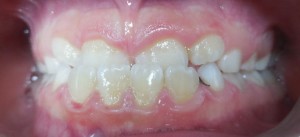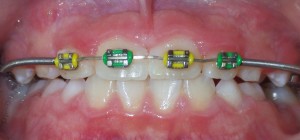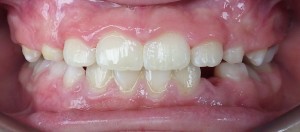What is it and why is it needed?
Sometimes parents remark “My eight-year old daughter’s friends already have braces. Isn’t that too early?” The easy answer is in general, yes, however, there is a small percentage of patients (maybe 10-15%) that can benefit from early treatment. Early treatment, also known as phase I, is any orthodontic treatment that begins while there is still a mix of baby teeth and permanent teeth. Phase II, would therefore be any secondary treatment that comes later when all the adult teeth have erupted.
First Evaluation by Age 7
Our professional association, the American Association of Orthodontists recommends the first orthodontic screening at age seven. By this time, children should have the first permanent molars (6-year molars) in addition to the permanent front four teeth on the top and bottom. From here, the orthodontic professional can characterize the type of bite that has developed and identify early issues such as crowding, spacing, crossbites, and underbites. Some of these issues are more successfully treated when addressed early.
Benefits of Early Orthodontic Treatment
Early treatment can have many benefits including but not limited to:
- Facilitating ideal growth and direction of the jaws
- Increasing the chance of achieving an ideal bite
- Creating room for permanent teeth
- Minimizing the chance of having to remove permanent teeth
- Avoiding worsening problems in the future
- Improving self-esteem during the formative school-age years
Palatal Expander
The literature supports early treatment for several orthodontic issues including crossbite of the back teeth, crossbite of the front teeth, and underbite, among several others. The most widely known appliance for early treatment is the palatal expander, used to correct a crossbite of the back teeth. This rigid metal framework made in a lab is custom fit and has a central screw that when turned with a key facilitates widening of the upper jaw. It’s important to note that the upper jaw has a suture that runs across the roof of the mouth. At a young age, the suture is patent and the two halves of the upper jaw can be widened. But as a patient grows and develops, the number of fibrous connections across this suture increase, making it more difficult (and less recommended) to separate the two halves of the upper jaw. In the presence of a crossbite of the back teeth, the upper teeth are tucked on the inside of the lower teeth, and this can be noticeable on one side or both sides of the upper jaw. The expander is ideally used between the ages of 7 and 10. After widening the upper jaw, both jaws are able to grow unhindered in the ideal forward direction rather than having the lower jaw skewed towards one side and affecting the alignment of the front teeth.
In the case of an expander treatment, most early treatments will have some component of limited braces. We finish a phase I expander treatment with four braces across the top. Our young patients love choosing different colors for their braces and finishing with straight teeth and a nice smile makes the experience at the orthodontist is a positive one!
Goals of Early Treatment
The goals of early treatment are limited and treatment time is typically 6-9 months. My goal as an orthodontic professional is to help all elementary school aged children have an evaluation at the appropriate time. It’s my job to identify those cases that would benefit greatly from early intervention for many of the important reasons listed above. Early treatments are also limited in nature, and my experience has been that young kids tolerate treatment extremely well and are adaptable to new things. I want younger patients to have a very positive experience with early treatment, feel good about their teeth and be comfortable with braces and orthodontics for the future.
Treatment for an Underbite
To bring your child in for a complimentary early treatment evaluation, please contact Farmington Valley Orthodontics at 860-673-6105 or check us out on the web at www.iwantbraces.com.




